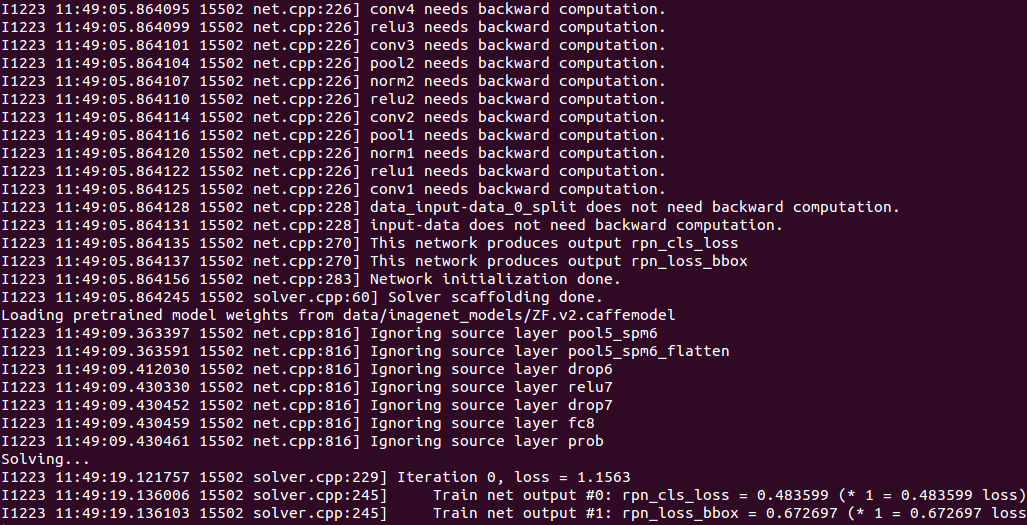Faster R-CNN训练与测试
demo.py修改:#!/usr/bin/env python# --------------------------------------------------------# Faster R-CNN# Copyright (c) 2015 Microsoft# Licensed under The MIT License [see LICENSE for det
转载请注明:http://blog.csdn.net/forest_world
demo.py修改:
#!/usr/bin/env python
# --------------------------------------------------------
# Faster R-CNN
# Copyright (c) 2015 Microsoft
# Licensed under The MIT License [see LICENSE for details]
# Written by Ross Girshick
# --------------------------------------------------------
"""
Demo script showing detections in sample images.
See README.md for installation instructions before running.
"""
import _init_paths
from fast_rcnn.config import cfg
from fast_rcnn.test import im_detect
from fast_rcnn.nms_wrapper import nms
from utils.timer import Timer
import matplotlib.pyplot as plt
import numpy as np
import scipy.io as sio
import caffe, os, sys, cv2
import argparse
CLASSES = ('__background__',
'aeroplane', 'bicycle', 'bird', 'boat',
'bottle', 'bus', 'car', 'cat', 'chair',
'cow', 'diningtable', 'dog', 'horse',
'motorbike', 'person', 'pottedplant',
'sheep', 'sofa', 'train', 'tvmonitor')
NETS = {'vgg16': ('VGG16',
'VGG16_faster_rcnn_final.caffemodel'),
'zf': ('ZF',
'ZF_faster_rcnn_final.caffemodel')}
def vis_detections(im, class_name, dets, thresh=0.5):
"""Draw detected bounding boxes."""
inds = np.where(dets[:, -1] >= thresh)[0]
if len(inds) == 0:
return
im = im[:, :, (2, 1, 0)]
fig, ax = plt.subplots(figsize=(12, 12))
ax.imshow(im, aspect='equal')
for i in inds:
bbox = dets[i, :4]
score = dets[i, -1]
ax.add_patch(
plt.Rectangle((bbox[0], bbox[1]),
bbox[2] - bbox[0],
bbox[3] - bbox[1], fill=False,
edgecolor='red', linewidth=3.5)
)
ax.text(bbox[0], bbox[1] - 2,
'{:s} {:.3f}'.format(class_name, score),
bbox=dict(facecolor='blue', alpha=0.5),
fontsize=14, color='white')
ax.set_title(('{} detections with '
'p({} | box) >= {:.1f}').format(class_name, class_name,
thresh),
fontsize=14)
plt.axis('off')
plt.tight_layout()
plt.draw()
def demo(net, image_name):
"""Detect object classes in an image using pre-computed object proposals."""
# Load the demo image
im_file = os.path.join(cfg.DATA_DIR, 'demo', image_name)
im = cv2.imread(im_file)
# Detect all object classes and regress object bounds
timer = Timer()
timer.tic()
scores, boxes = im_detect(net, im)
timer.toc()
print ('Detection took {:.3f}s for '
'{:d} object proposals').format(timer.total_time, boxes.shape[0])
# Visualize detections for each class
CONF_THRESH = 0.8
NMS_THRESH = 0.3
for cls_ind, cls in enumerate(CLASSES[1:]):
cls_ind += 1 # because we skipped background
cls_boxes = boxes[:, 4*cls_ind:4*(cls_ind + 1)]
cls_scores = scores[:, cls_ind]
dets = np.hstack((cls_boxes,
cls_scores[:, np.newaxis])).astype(np.float32)
keep = nms(dets, NMS_THRESH)
dets = dets[keep, :]
vis_detections(im, cls, dets, thresh=CONF_THRESH)
def parse_args():
"""Parse input arguments."""
parser = argparse.ArgumentParser(description='Faster R-CNN demo')
#parser.add_argument('--gpu', dest='gpu_id', help='GPU device id to use [0]',
#default=0, type=int)
parser.add_argument('--cpu', dest='cpu_mode',
help='Use CPU mode (overrides --gpu)',
action='store_true')
parser.add_argument('--net', dest='demo_net', help='Network to use [vgg16]',
choices=NETS.keys(), default='vgg16')
args = parser.parse_args()
return args
if __name__ == '__main__':
cfg.TEST.HAS_RPN = True # Use RPN for proposals
args = parse_args()
prototxt = os.path.join(cfg.MODELS_DIR, NETS[args.demo_net][0],
'faster_rcnn_alt_opt', 'faster_rcnn_test.pt')
caffemodel = os.path.join(cfg.DATA_DIR, 'faster_rcnn_models',
NETS[args.demo_net][1])
if not os.path.isfile(caffemodel):
raise IOError(('{:s} not found.\nDid you run ./data/script/'
'fetch_faster_rcnn_models.sh?').format(caffemodel))
if args.cpu_mode:
caffe.set_mode_cpu()
else:
caffe.set_mode_cpu()
#caffe.set_mode_gpu()
#caffe.set_device(args.gpu_id)
#cfg.GPU_ID = args.gpu_id
net = caffe.Net(prototxt, caffemodel, caffe.TEST)
print '\n\nLoaded network {:s}'.format(caffemodel)
# Warmup on a dummy image
im = 128 * np.ones((300, 500, 3), dtype=np.uint8)
for i in xrange(2):
_, _= im_detect(net, im)
im_names = ['000456.jpg', '000542.jpg', '001150.jpg',
'001763.jpg', '004545.jpg']
for im_name in im_names:
print '~~~~~~~~~~~~~~~~~~~~~~~~~~~~~~~~~~~'
print 'Demo for data/demo/{}'.format(im_name)
demo(net, im_name)
plt.show()
参考资料:
http://blog.csdn.net/zhang_shuai12/article/details/52295438 py-faster-rcnn + cpu安装及训练自己的数据集
http://blog.csdn.net/u012675539/article/details/53537271 Fast rcnn cpu 训练自己的数据
http://blog.sina.com.cn/s/blog_679f93560102wpyf.html Faster R-CNN安装笔记,只用CPU
http://www.cnblogs.com/justinzhang/p/5386837.html Faster R-CNN CPU环境搭建
http://blog.csdn.net/z18234132948/article/details/53483791 ubuntu14.04+CPU环境下搭建caffe,python接口以及运行
fast-rcnn实例
http://blog.csdn.net/u013657981/article/details/49497753 在windows下用caffe跑ImageNet
http://blog.csdn.net/drdeep/article/details/50835974 深度学习Imagenet caffe AlexNet 实验步骤
@ubuntu:~/faster_rcnn/py-faster-rcnn/caffe-fast-rcnn$ ./tools/demo.py --cpu
http://stackoverflow.com/questions/28177298/import-caffe-error
cd $FRCN_ROOT/caffe-fast-rcnn
make -j8 && make pycaffe
更多推荐
 已为社区贡献6条内容
已为社区贡献6条内容









所有评论(0)